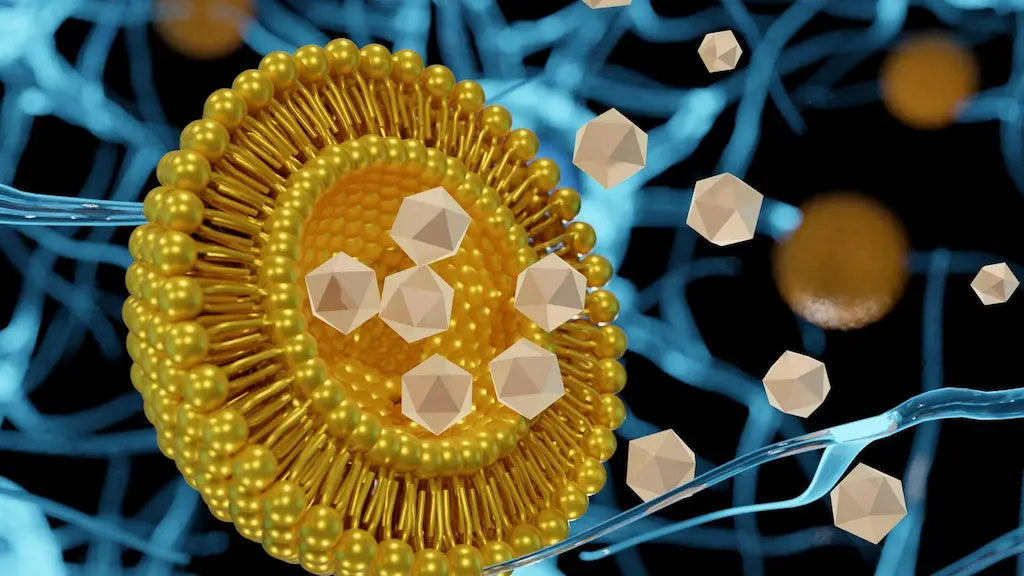Liposomes, tiny, bubble-like capsules made of natural fats that can carry molecules such as NMN, are useful because their structure allows them to protect fragile compounds and help them pass through barriers like the skin.
Key Points
- TCR produced uniform NMN liposomes, outperforming traditional methods
- Liposomes retained up to 90% NMN after 180 days
- Skin penetration improved dramatically, reaching nearly complete delivery
- Findings highlight NMN liposomes as next-generation delivery system

How the Liposomes Were Made and Measured
Researchers created NMN liposomes using a Taylor-Couette reactor, which mixes liquids by spinning one cylinder inside another to create a controlled swirling motion that blend the ingredients evenly and reliably.
To prepare the liposomes, NMN dissolved in water was combined with a natural fat that forms the liposome shell, inside the reactor. For comparison, traditional liposomes were also made in a simple flask using a standard stirring method.
Stability Testing Methods
- Because NMN is known to break down quickly in water, the team tested whether liposomal encapsulation could protect it.
- Both free NMN solution and liposomal NMN were stored at different conditions: Room temperature (25 °C), Moderate heat (40 °C), & High heat (60 °C).
- Samples were checked over 180 days (six months) to see how much NMN was still intact.
Skin Penetration Testing Methods
- To measure skin penetration, researchers used a Franz diffusion cell, stretching a thin piece of pig skin across a chamber.
- The top was covered with liposome solution, like a cream and NMN molecules that successfully traveled through the skin were caught underneath.
- This allowed the team to calculate how well liposomes delivered NMN across the barrier.

Liposomes Protect NMN Against Degradation
Liposomes produced at higher speeds were most stable while free NMN degraded almost completely within 30 days.
"The free NMN group degraded almost completely within 30 days at room temperature."
In comparison, TCR liposomes kept about 87–89% of the NMN intact even after six months, showing that they provided strong protection.
"After 180 days at room temperature, the retention rate of NMN in the TCR liposome samples was 87–89%."
Even when stored at 40 °C (104 °F), the liposomal NMN kept around 86% of its content after a month, while plain NMN without protection had almost completely broken down.
"At 40 °C, liposomal NMN maintained ~86% content after one month, while free NMN was nearly destroyed."
Only at 60 °C (140 °F) did degradation accelerate across all groups.
"At 60 °C, liposome samples rapidly collapsed, and the NMN peak disappeared after 30 days in all groups. Liposomes produced at higher speeds (1000–1500 rpm) were the most stable."
Skin Penetration & Delivery Improved
Franz diffusion tests confirmed high skin permeability. Without external force, nearly 71% of liposomal NMN penetrated the skin after 18 hours.
"Franz cell diffusion further validated the efficacy of NMN loaded liposomes in penetrating the skin barrier. The results showed the penetration percentage converges to 70.7% after 18 h."
With a simple tapping application, penetration increased to 96.8% in just 12 hours.
"With the application of a driving force, the penetration percentage reaches 96.8% within 12 h, showing that mostly all liposomes penetrate the dermal layer."
This shows that liposomes not only protect NMN from breaking down but also serve as effective carriers for delivering it through the skin. Previous research on liposomal NMN preparation established foundational methods for encapsulating NMN, and this new Taylor-Couette approach represents a significant advancement in achieving superior stability and uniformity.
Taylor-Couette Mixing Improves Liposome Quality
In the TCR, faster spinning speeds created smooth, organized whirlpools that mixed the ingredients evenly.
"This observation suggests that as the rotational speed increases, the flow velocity of the fluid also increases, leading to faster and more vigorous mixing of the oil and aqueous phases."
Traditionally prepared liposomes appeared darker, a sign of poor mixing, whereas those produced in the TCR were lighter in color, more uniform, and visually more stable.
"Liposomes prepared using the flask stirring method exhibited darker color, whereas the NMN liposome samples produced using TCR appeared lighter, indicating superior emulsification stability."
As the reactor spun faster, the liposomes became smaller and more consistent in size. They also carried a stronger negative charge, which made them push away from each other, preventing clumping and keeping the solution stable.
"This strong negative charge provides electrostatic repulsion between particles, preventing aggregation and maintaining dispersion stability."

Conclusions: Implications for NMN and NAD+ Restoration
This study shows that the Taylor-Couette reactor can make high-quality NMN liposomes that solve two major problems with NMN: rapid breakdown and poor absorption.
The reactor's controlled mixing created NMN liposomes that remained stable for at least six months under normal storage conditions.
"The NMN liposome samples created using TCR demonstrated remarkable stability… remaining highly stable when stored at room temperature for six months."
In addition to keeping NMN stable, the liposomes delivered it efficiently, with almost three-quarters of the NMN crossing the skin within 18 hours.
"The penetration percentage reaches 70.7% after 18 h without any external force."
By stabilizing NMN and enhancing skin absorption, this technology supports new approaches to restoring NAD+ levels for applications in aging, metabolic health, and skin care. Clinical studies comparing liposomal NMN to standard formulations have demonstrated that advanced delivery systems can significantly improve bioavailability and NAD+ boosting effects in humans.
"This innovative delivery method holds great promise for improving the bioavailability of NMN and other active ingredients in cosmetic and pharmaceutical applications."



